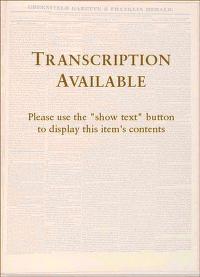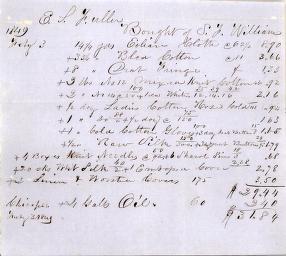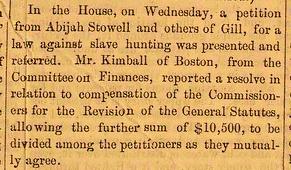|

"Arrest of a Fugitive Slave in Boston" article from Gazette and Courier newspaper

"Lowell" article regarding cotton mills from Greenfield Gazette and Franklin Herald newspaper

Bill to Elijah Fuller regarding cotton

"News Items"- Mass. Petitions to abolish slave-hunting

"Legislature- slave hunting petition"
|
Summary and Objective
The Fugitive Slave Law portion of the 1850 Compromise provided a complicated mixture of opinions regarding how far the North was willing to go to keep the Union intact. Through investigative learning using primary sources, and differentiated instruction and assessment using student choice, students will understand that the Fugitive Slave Law and the rescue of Shadrach Minkins had a widely varied impact on citizens in Massachusetts. Students will also understand that the opinions regarding actions surrounding fugitive slaves varied. In addition, students will understand that the larger difficulties within the Union were symbolized and highlighted by the argument over fugitive slaves in Boston.
Teaching Plan
Step 1.
Pre-Activity: Assign students three primary sources for homework (Students can either access online, or teacher can copy and paste onto a worksheet for students)
• “Compromise of 1850” from links at bottom- Students should read the background information, then click on “4th Statute” and read sections 1,5,6 & 7 and consider what the law requires, who can be arrested, what problems might this law cause in the North, and how this was meant to keep the North and South together-Will it work?
• Background on the Shadrach Minkins rescue from MassMoments-Students should note background events and information on the rescue
• “Arrest of a Fugitive Slave” from the Gazette & Courier- Use article to discover initial report of the Minkins rescue-was this an unbiased report?
Step 2.
At the start of class, ask students to form pairs or small groups and compare their background information on the Fugitive Slave Act, the purpose of the Compromise of 1850, and the events surrounding the capture and rescue of Shadrach Minkins in Boston. Students should then, as a whole class, create a flow chart on the board or poster paper showing cause and effect of these events.
Step 3.
Students should separate into three investigative groups. Each group will use a collection of primary source documents to understand and note the opinions of people around Boston regarding the Fugitive Slave Act, the Compromise, the Minkins rescue, and the efforts behind keeping the Union together. As with the homework, students can either use this resource directly online in a computer lab, or teacher-provided copies of the documents.
GROUP ONE:
• “Lowell Article Regarding Cotton Mills”-What do the figures and information demonstrate regarding the importance of cotton to the Boston area’s mills-How is a cheap price obtained from cotton farmers in the South-Why would businessmen in Boston want to strengthen ties with southern planters-How would they feel about slavery?
• “Bill to Elijah Fuller”-What transactions are occurring here-How would Fuller feel about the Fugitive Slave Law and the Minkins escape?
• “Proclamation by the President” from Franklin Democrat, 2-24-1851 – What is President Fillmore’s reaction to the Minkins rescue-What does he call on the citizens of Boston to do-Why does he word his proclamation so strongly-What do you think he is worried about because of this rescue?
• “The Boston Mob” Gazette & Courier, March 31, 1851- What does Secretary of State Daniel Webster (from Massachusetts) ask the citizens of Boston to do-As someone in favor of the 1850 Compromise, why would Webster write this-What is he “Quite sure” of regarding Boston’s citizens?
Step 4.
GROUP TWO:
•"News Items-Mass. Petition to Abolish Slave Hunting”-What does this short article tell you about the growing opposition to the Fugitive Slave Act-Why do you think people were growing angry with the required enforcement of the law just a few weeks after the Minkins rescue-What would be the objections to the law?
• “Legislature-Slave Hunting Petition”- By 1860, opinions had changed drastically-What evidence in this article tells you about the change in opinion-What language is used to demonstrate emotions regarding enforcement of the Slave Act?
• “The Boston Mob”-Gazette & Courier, 2-24-1851- What does this article tell you about the argument regarding who was to be responsible for securing fugitive slaves-Why is that argument important-What point of view does this article take regarding fugitive slaves?
Step 5.
GROUP THREE:
• Austin Bearse-“Reminiscences of Fugitive-Slave Law Days in Boston” pg 16-20 – How does this pamphlet characterize the Fugitive Slave Law-How does it characterize its proponents, especially President Fillmore and Daniel Webster-What does it say about the choice Boston needs to make regarding obeying or fighting the slave law-How is the Minkins rescue a symbol of the controversy?
• “The Boston Commonwealth contains a report…” (Probably Gazette and Courier, not noted) – What point of view does this article take regarding those accused of helping Minkins escape-What does the article say about rights and revolution, and how the idea of the American Revolution, born in Boston, applies to fugitive slaves?
Step 6.
Groups should now share their findings with the whole class by creating construction-paper sized annotations on the sources and opinions. Students should place these annotations on a “spectrum of opinion” (Pro Fugitive Slave Act ranging to anti-fugitive slave law) on the classroom wall or board. Students should explain the opinions they encountered, and describe why they are placing the opinions where they are on the spectrum. This jigsaw activity will allow all students to benefit from all of the primary sources.
Step 7.
Day Two: Students will now participate in a “Choices” activity-students may work alone or in pairs, and choose from the following activities that will demonstrate their understanding of the concepts and serve as an assessment for the topic. Students will create and then present their projects.
• Create a poster, web, or flow chart that demonstrates and explains the varying opinions in the North surrounding the Fugitive Slave Act and/or the Minkins rescue
• Draw/create propaganda posters or broadsides both for and against the Fugitive Slave Act or the Minkins Rescue
• Write speeches from 1851 both for and against the Fugitive Slave Act and the Minkins rescue
• Create a debate from 1851 that demonstrates various points of view regarding the Fugitive Slave Law and the Minkins rescue
• Write newspaper articles from newspapers both supporting and opposing the Fugitive Slave Law and the Minkins rescue
Step 8.
Post-Activity: Teacher should facilitate a student discussion and/or debate regarding the effectiveness of the Fugitive Slave Law and the importance of the Minkins rescue as a symbol of the controversy regarding the intent and effectiveness of the Fugitive Slave Law in particular, and the 1850 Compromise in general. This can be an informal discussion or a brief “2-corners” debate.
|




